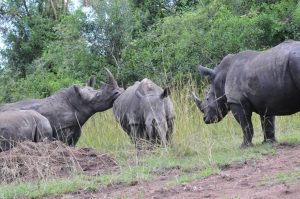Rhinos in Uganda
 Rhinos in Uganda live wildly at Ziwa Rhino Sanctuary and a small number in the zoo setting at the Uganda Wildlife Education Center Entebbe. Rhinos in Uganda became extinct due to the 1970s and 80s civil insecurities and lawlessness that gave way to poaching, trafficking and encroachment on wildlife areas. A long-term plan for reintroducing Rhinos in the Uganda wildlife parks was embarked on in the early 2000s and this started with establishing Ziwa Rhino Sanctuary to ensure Rhino breeding and multiplication. The sanctuary started with 6 Rhinos and the number has been steadily increasing. It should be noted that both the Black Rhinoceros and the Northern White Rhinoceros are indigenous to Uganda but currently are only the Southern White Rhinoceros which number to a little over 30.
Rhinos in Uganda live wildly at Ziwa Rhino Sanctuary and a small number in the zoo setting at the Uganda Wildlife Education Center Entebbe. Rhinos in Uganda became extinct due to the 1970s and 80s civil insecurities and lawlessness that gave way to poaching, trafficking and encroachment on wildlife areas. A long-term plan for reintroducing Rhinos in the Uganda wildlife parks was embarked on in the early 2000s and this started with establishing Ziwa Rhino Sanctuary to ensure Rhino breeding and multiplication. The sanctuary started with 6 Rhinos and the number has been steadily increasing. It should be noted that both the Black Rhinoceros and the Northern White Rhinoceros are indigenous to Uganda but currently are only the Southern White Rhinoceros which number to a little over 30.
Interesting facts about Rhinos
The Rhinoceros or the Rhino as it is commonly called, is a large herbivorous mammal identified by its characteristic horned snout. From other animals, a Rhino can be identified by its massive body, stumpy legs, and either one or two dermal horns. In some species, the horns might be short or not obvious. Check classification of Rhinos here.
Rhinos are ungulates with horses as their closest relatives. A group of them is called a crash or herd. An adult male Rhino can weigh up to 3.6 tons while the female 2.5 to 2.7 tons. On average, Rhinos can live up to 45 years in the wild and 50 in captivity or settings such as zoos.
Rhinos are peaceful and live as a family. They do not compete with other animals and so are not known to attack them.
Interestingly, Rhinos have a small brain of about 400 to 600gms. Too small for mammals of their size! They have a poor eyesight but with well-developed senses of hearing and smell.
Rhinos don’t have sweat glands and so wallowing in small ponds in their habitats allows them to cool off. Advantageously, the muddy pond waters in which they wallow is a good remedy to ticks and biting insects in the wild.
Gestation period of a Rhino
The female carries a pregnancy for 16 months. The young one called a calf can weigh up to about 15 kilograms at birth.
Feeding habits of Rhinos
Rhinos are one of the biggest herbivores with the ability to averagely feed on 100kilograms of grass every day. They can feed for 14 hours, mostly in the night. They are largely lazy during the day. They would prefer to sleep when it’s hot. Rhinos are more active when it’s cooler.
Where to find Rhinos in Uganda
On a Uganda Safari tour, Rhinos are found at Ziwa Rhino Sanctuary near Murchison Falls National Park and the Uganda Wildlife Education Center in Entebbe near the airport. There are no Rhinos in Uganda National Parks and Reserves but long-term plans by the Uganda Wildlife Authority and Rhino Fund Uganda of having Rhinos relocated back to their original habitat in the protected areas exist.
Threats to Rhinos in Uganda
Rhinos are a target from poachers who kill them for their horns. Luckily, there hasn’t been any cases of poaching or killings since their re-introduction in Uganda in the early 2000s. In some Asian countries of China and Yemen, it’s believed that the horn powder can cure cancer which myth has been disproved by scientists every now and again. The main predator to the Rhino is the leopard.
Tours to see Rhinos in Uganda
- 1 day Rhino tracking Tour
- 2 Days Murchison Falls with Rhinos
- 3 Days Murchison Falls Safari
- Murchison Falls Tour
- 5 Days Murchison Birding, Shoebill and Rhinos